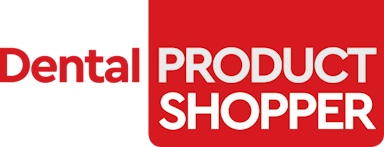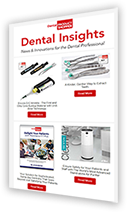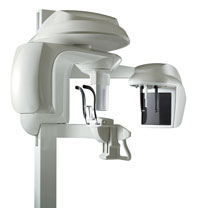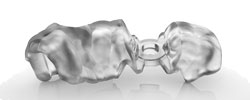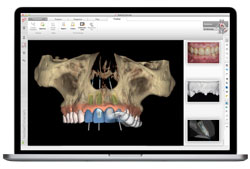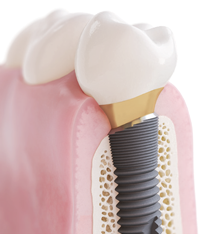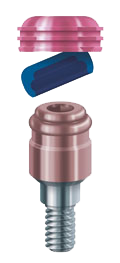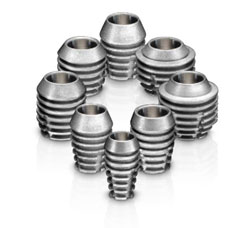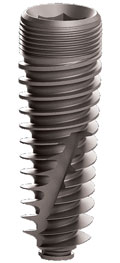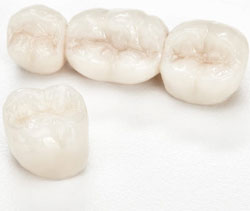IMPLANTS: A GUIDED APPROACH
With guided implant surgery as the standard of care, implant dentistry continues to evolve and improve with ongoing advancements in implant design, diagnostics and treatment planning,and adjunct techniques.
$6.4 BILLION
THE PROJECTED U.S. DENTAL IMPLANT AND PROSTHETIC MARKET IN 2018
It’s not an overstatement to say that implantology is the hottest, fastestgrowing discipline in dentistry. One seemingly small development certainly supports this.
Recently, a suit was filed in Texas to overturn restrictions on dentists “advertising” their credentials in areas not officially sanctioned by the ADA. The judge ruled for the plaintiffs, allowing them to make their credentials known “so long as the advertisements avoided communications expressing or implying a specialization.”
Specifically, the plaintiffs wanted to display their official accreditation by the American Board of Oral Implantology, chartered by the American Academy of Implant Dentistry.
This case has been cited as the motivation for the even more recent and uncharacteristic move by the ADA House of Delegates. At its meeting during the 2016 ADA Annual Session, the House of Delegates amended the ADA Principles of Ethics and Code of Professional Conduct, acknowledging—and permitting announcement of—dental specialties recognized in a practitioner’s jurisdiction, even if not formally recognized by the ADA.
In light of its well-known conservative history, the ADA’s official statement was surprisingly radical:
“The professional landscape concerning the recognition of specialties has undergone dramatic change. Over the past several years, compelled by court decisions, states have begun to recognize specialties beyond the 9 dental specialties recognized by the ADA.”
So, the groundwork is laid. Implantology is widely thought to be on track as the first candidate for a new dental specialty.
While diagnostic and treatment techniques are simpler and more predictable than ever—thanks in large part to digital technologies— the placement and restoration of implants remains a complex multiphase process requiring specialized training. From diagnosis, assessment, and treatment planning to bone grafting, surgical placement, and follow-up, each step is critical in ensuring a successful outcome.
On the following pages, the Dental Product Shopper editorial team spotlights several product categories, each critical to one or more phases of providing dental implant services.
GUIDED SURGERY
Surgical guides are the new standard of care for successful implant placement. The approach is not totally new, but is now easier and more precise thanks to digital imaging and the use of virtual, instead of physical, models.
Carestream Dental recently launched an innovative digital implant approach. CS Solutions for Implants integrates diagnosis, treatment planning, and patient/referral communication, combining 3D technologies with prosthetic-driven implant treatment. After a scan is used to create a virtual setup, the CS 3D Imaging Software module (pictured, page 54) for prosthetic-driven implant planning enables the clinician to plan the crown and the implant on the same screen. This provides maximum control over final clinical and esthetic outcomes. Read on to learn about other component systems involved in the guided surgery approach.
3D IMAGING Imaging Sciences’ i-CAT brand has the longest history for CBCT in dentistry. With QuickScan+ technology, the latest-generation i-CAT FLX captures a 3D image with less radiation exposure than a 2D pan.
The GXDP-700 Series from Gendex is a modular 3-in-1 pan, ceph, and 3D system that can be easily upgraded depending on practice needs.
The ORTHOPANTOMOGRAPH cone beam brand from Instrumentarium comprises the OP300, with FOV specifically optimized imaging parameters, and the OP300 Maxio for maximum imaging capacity for the entire maxillofacial region.
Several companies offer both intraoral and extraoral options for capturing 3D images to create virtual models.
Dentsply Sirona Extraoral offers 2 cone beam options: the dedicated 3D GALILEOS ComfortPLUS and the ORTHOPHOS hybrid imaging systems. Also available are 2 intraoral scanners, the feature-rich Omnicam and the entry-level Bluecam.
The Planmeca ProMax 3D family brings together 3 different types of 3D data—a CBCT image, 3D face photo, and 3D model scan—into one 3D image, using the same advanced software. This combination creates a virtual patient in 3D.
For intraoral 3D scanning, Carestream’s CS 3500 and CS 3600 feature a proprietary light guidance system for fast, accurate scanning. Carestream’s extraoral options include the CS 9000 3D and the CS 9300 cone beam systems.
Recently, a suit was filed in Texas to overturn restrictions on dentists “advertising” their credentials in areas not officially sanctioned by the ADA. The judge ruled for the plaintiffs, allowing them to make their credentials known “so long as the advertisements avoided communications expressing or implying a specialization.”
Specifically, the plaintiffs wanted to display their official accreditation by the American Board of Oral Implantology, chartered by the American Academy of Implant Dentistry.
This case has been cited as the motivation for the even more recent and uncharacteristic move by the ADA House of Delegates. At its meeting during the 2016 ADA Annual Session, the House of Delegates amended the ADA Principles of Ethics and Code of Professional Conduct, acknowledging—and permitting announcement of—dental specialties recognized in a practitioner’s jurisdiction, even if not formally recognized by the ADA.
In light of its well-known conservative history, the ADA’s official statement was surprisingly radical:
“The professional landscape concerning the recognition of specialties has undergone dramatic change. Over the past several years, compelled by court decisions, states have begun to recognize specialties beyond the 9 dental specialties recognized by the ADA.”
So, the groundwork is laid. Implantology is widely thought to be on track as the first candidate for a new dental specialty.
While diagnostic and treatment techniques are simpler and more predictable than ever—thanks in large part to digital technologies— the placement and restoration of implants remains a complex multiphase process requiring specialized training. From diagnosis, assessment, and treatment planning to bone grafting, surgical placement, and follow-up, each step is critical in ensuring a successful outcome.
On the following pages, the Dental Product Shopper editorial team spotlights several product categories, each critical to one or more phases of providing dental implant services.
GUIDED SURGERY
Surgical guides are the new standard of care for successful implant placement. The approach is not totally new, but is now easier and more precise thanks to digital imaging and the use of virtual, instead of physical, models.
Carestream Dental recently launched an innovative digital implant approach. CS Solutions for Implants integrates diagnosis, treatment planning, and patient/referral communication, combining 3D technologies with prosthetic-driven implant treatment. After a scan is used to create a virtual setup, the CS 3D Imaging Software module (pictured, page 54) for prosthetic-driven implant planning enables the clinician to plan the crown and the implant on the same screen. This provides maximum control over final clinical and esthetic outcomes. Read on to learn about other component systems involved in the guided surgery approach.
3D IMAGING Imaging Sciences’ i-CAT brand has the longest history for CBCT in dentistry. With QuickScan+ technology, the latest-generation i-CAT FLX captures a 3D image with less radiation exposure than a 2D pan.
The GXDP-700 Series from Gendex is a modular 3-in-1 pan, ceph, and 3D system that can be easily upgraded depending on practice needs.
The ORTHOPANTOMOGRAPH cone beam brand from Instrumentarium comprises the OP300, with FOV specifically optimized imaging parameters, and the OP300 Maxio for maximum imaging capacity for the entire maxillofacial region.
Several companies offer both intraoral and extraoral options for capturing 3D images to create virtual models.
Dentsply Sirona Extraoral offers 2 cone beam options: the dedicated 3D GALILEOS ComfortPLUS and the ORTHOPHOS hybrid imaging systems. Also available are 2 intraoral scanners, the feature-rich Omnicam and the entry-level Bluecam.
The Planmeca ProMax 3D family brings together 3 different types of 3D data—a CBCT image, 3D face photo, and 3D model scan—into one 3D image, using the same advanced software. This combination creates a virtual patient in 3D.
For intraoral 3D scanning, Carestream’s CS 3500 and CS 3600 feature a proprietary light guidance system for fast, accurate scanning. Carestream’s extraoral options include the CS 9000 3D and the CS 9300 cone beam systems.
DOCTOR’S FAVORITES
 Dr. Kaveh Ghaboussi is a general dentist with a comprehensive practice in Madison, WI. With a Mastership in the American Dental Implant Association, he regularly places implants and recently shared his go-to products with Dental Product Shopper.
Dr. Kaveh Ghaboussi is a general dentist with a comprehensive practice in Madison, WI. With a Mastership in the American Dental Implant Association, he regularly places implants and recently shared his go-to products with Dental Product Shopper.
The information I have received from CBCT scans has been critical in deciding whether to pursue implant treatment. I purchased Instrumentarium’s OP300 about 4 years ago, and today I could not practice without it. With its Low-Dose Technology, Automatic Dose Control, and CLINVIEW software, the OP300 has offered many benefits, like expanded services, increased diagnostic accuracy, and renewed passion among my entire team.
I am a big proponent of surgical guides, and use the services of Anatomage. I like the intuitive and powerful Invivo5 software as well as the reliable service and turnaround for the Anatomage Guide.
The implants I place most frequently are from OCO Biomedical. Depending on the case, I typically use Engage bone-level implants or TSI 2-piece tapered.
For grafting, I have found that combining OsteoLife Biomedical’s bone products with Bone Binder (Woodland Hills Pharmacy) is the easiest, most reliable, and most economical approach.
 Dr. Kaveh Ghaboussi is a general dentist with a comprehensive practice in Madison, WI. With a Mastership in the American Dental Implant Association, he regularly places implants and recently shared his go-to products with Dental Product Shopper.
Dr. Kaveh Ghaboussi is a general dentist with a comprehensive practice in Madison, WI. With a Mastership in the American Dental Implant Association, he regularly places implants and recently shared his go-to products with Dental Product Shopper.The information I have received from CBCT scans has been critical in deciding whether to pursue implant treatment. I purchased Instrumentarium’s OP300 about 4 years ago, and today I could not practice without it. With its Low-Dose Technology, Automatic Dose Control, and CLINVIEW software, the OP300 has offered many benefits, like expanded services, increased diagnostic accuracy, and renewed passion among my entire team.
I am a big proponent of surgical guides, and use the services of Anatomage. I like the intuitive and powerful Invivo5 software as well as the reliable service and turnaround for the Anatomage Guide.
The implants I place most frequently are from OCO Biomedical. Depending on the case, I typically use Engage bone-level implants or TSI 2-piece tapered.
For grafting, I have found that combining OsteoLife Biomedical’s bone products with Bone Binder (Woodland Hills Pharmacy) is the easiest, most reliable, and most economical approach.
Surgical Guides: Design and Fabrication
Guided surgery techniques eliminate guesswork by precisely indicating the planned direction and depth during insertion. The protocol typically involves working with a lab, manufacturer, or other specialized service for fabrication of the actual customized guide.
That said, Dentsply Sirona CAD/CAM’s CEREC Guide 2 allows fabrication of a surgical guide in less than an hour.
Using the CEREC CAD/CAM workflow, the simple 4-step process involves taking an intraoral scan, treatment planning with CBCT scans, designing the drilling guide with CEREC software, and milling the guide from PMMA plastic.
Here are several other available products and services for guided implant surgery...
Guided Surgery Solutions offers the ThinLayer Guide System, which is transparent for maximum site visibility and access. It is modifiable in surgery and incorporates the Perfect Pilot pilot hole drill stop.
Nobel Biocare’s NobelGuide is a complete treatment concept based on user-friendly NobelClinician Software. It can produce guided pilot drilling for partially edentulous cases as well as fully guided implant insertion.
BioHorizons’ Guided Surgery Kit includes all color-coded components in a streamlined, single-kit design. Its open architecture is compatible with several fabrication options.
Compatible with more than 100 brands of implants, SIMPLANT from Dentsply Sirona Implants can be used with most manufacturers’ cone-beam and intraoral scanners. Its FastTrack order option provides guides in 48 hours.
Straumann’s Soft Tissue Level and Bone Level Guided Implants and mucosa punches are compatible with the same guided surgery software as the Straumann Guided Surgery Instrument Kit, helping to perform minimally invasive surgery.
That said, Dentsply Sirona CAD/CAM’s CEREC Guide 2 allows fabrication of a surgical guide in less than an hour.
Using the CEREC CAD/CAM workflow, the simple 4-step process involves taking an intraoral scan, treatment planning with CBCT scans, designing the drilling guide with CEREC software, and milling the guide from PMMA plastic.
Here are several other available products and services for guided implant surgery...
Guided Surgery Solutions offers the ThinLayer Guide System, which is transparent for maximum site visibility and access. It is modifiable in surgery and incorporates the Perfect Pilot pilot hole drill stop.
Nobel Biocare’s NobelGuide is a complete treatment concept based on user-friendly NobelClinician Software. It can produce guided pilot drilling for partially edentulous cases as well as fully guided implant insertion.
BioHorizons’ Guided Surgery Kit includes all color-coded components in a streamlined, single-kit design. Its open architecture is compatible with several fabrication options.
Compatible with more than 100 brands of implants, SIMPLANT from Dentsply Sirona Implants can be used with most manufacturers’ cone-beam and intraoral scanners. Its FastTrack order option provides guides in 48 hours.
Straumann’s Soft Tissue Level and Bone Level Guided Implants and mucosa punches are compatible with the same guided surgery software as the Straumann Guided Surgery Instrument Kit, helping to perform minimally invasive surgery.
SLOPED RIDGE? NO PROBLEM.
Have you ever tried to place a flat-top implant in a patient with sloped ridges? Probably, as it is estimated that more than a third of implant sites present with a sloped alveolar crest after healing. Typically, you'd have to compromise esthetics to preserve buccal/lingual marginal bone. Not anymore…
For grafting, I have found that combining OsteoLife Biomedical's bone products with Bone Binder (Woodland Hills Pharmacy) is the easiest, most reliable, and most economical approach.Dentsply Sirona Implants offers the OsseoSpeed Profile EV, especially designed to follow the natural contours of the sloped anatomy and maximizes existing bone. The result: optimized esthetics and marginal bone preservation.
"OsseoSpeed Profile implants are truly a practice changer when it comes to reconstructing naturally contoured ridges. An edentulous site, even after socket preservation, frequently has a 'high' and a 'low' side,' says Oral and Maxillofacial Surgeon Dr. Scott Van Dam.
"Sloping crestal bone is especially prevalent in the posterior mandible," Dr. Van Dam continues. "In this situation, a traditional implant leaves you with 2 options: Either you level the ridge by vertically reducing the 'high side'—thereby increasing the crown-to-implant ratio and potentially encroaching on the nerve or sinus—or you graft over the exposed threads on the 'low side'."
"In my practice, OsseoSpeed Profile implants are not a substitute for ridge augmentation, but rather an additional tool for appropriately managing the natural contours of post-extraction alveolar bone and achieving predictable results. In combination with 3D planning and guided surgery, they allow me to respect the natural contours of bone, place implants in a more ideal vertical position, do less grafting at the time of implant placement, and convert many difficult implant sites into straightforward ones."
Have you ever tried to place a flat-top implant in a patient with sloped ridges? Probably, as it is estimated that more than a third of implant sites present with a sloped alveolar crest after healing. Typically, you'd have to compromise esthetics to preserve buccal/lingual marginal bone. Not anymore…
For grafting, I have found that combining OsteoLife Biomedical's bone products with Bone Binder (Woodland Hills Pharmacy) is the easiest, most reliable, and most economical approach.Dentsply Sirona Implants offers the OsseoSpeed Profile EV, especially designed to follow the natural contours of the sloped anatomy and maximizes existing bone. The result: optimized esthetics and marginal bone preservation.
"OsseoSpeed Profile implants are truly a practice changer when it comes to reconstructing naturally contoured ridges. An edentulous site, even after socket preservation, frequently has a 'high' and a 'low' side,' says Oral and Maxillofacial Surgeon Dr. Scott Van Dam.
"Sloping crestal bone is especially prevalent in the posterior mandible," Dr. Van Dam continues. "In this situation, a traditional implant leaves you with 2 options: Either you level the ridge by vertically reducing the 'high side'—thereby increasing the crown-to-implant ratio and potentially encroaching on the nerve or sinus—or you graft over the exposed threads on the 'low side'."
"In my practice, OsseoSpeed Profile implants are not a substitute for ridge augmentation, but rather an additional tool for appropriately managing the natural contours of post-extraction alveolar bone and achieving predictable results. In combination with 3D planning and guided surgery, they allow me to respect the natural contours of bone, place implants in a more ideal vertical position, do less grafting at the time of implant placement, and convert many difficult implant sites into straightforward ones."
QUALITY CONTROL
The Schick 33 intraoral sensor combines high-resolution images and dynamic image management. The sensor’s patented imaging technology offers a theoretical resolution limit of 33 line pairs per millimeter, the highest in the industry.
Anthony Ramirez, DDS, said Schick 33 opened his eyes to newfound pathology and restorative needs for his patients.
“I use the Schick 33 x-rays to verify the accuracy of my implant placement during the actual surgery and continue to follow the implants for integration with the sensors as well,” Dr. Ramirez said. “My use of Schick 33 sensors spans all dental disciplines as x-rays can corroborate my clinical findings.”
The Schick 33 intraoral sensor combines high-resolution images and dynamic image management. The sensor’s patented imaging technology offers a theoretical resolution limit of 33 line pairs per millimeter, the highest in the industry.
Anthony Ramirez, DDS, said Schick 33 opened his eyes to newfound pathology and restorative needs for his patients.
“I use the Schick 33 x-rays to verify the accuracy of my implant placement during the actual surgery and continue to follow the implants for integration with the sensors as well,” Dr. Ramirez said. “My use of Schick 33 sensors spans all dental disciplines as x-rays can corroborate my clinical findings.”
Implants
Nobel Biocare’s newest addition is the On1 concept, a modular solution featuring the On1 Base that connects to the implant at surgery and remains in place through healing, restoration, and beyond. This leaves soft tissue undisturbed while maintaining restorative flexibility. Also recently launched, the NobelZygoma implant is designed specifically for cases with severe maxillary resorption.
For maximum resiliency with a minimal profile, SATURNO narrow-diameter implants from Zest Dental Solutions incorporate a proprietary angled O-ball option with pivoting O-ring technology. Zest also developed a SATURNO 20-degree angled implant option to address the challenges associated with implant placement in the maxillary ridge.
BioHorizons’ Tapered Internal Plus implant features platform switching to increase soft tissue volume around the implant connection and a proprietary Laser-Lok-coated zone to maintain crestal bone.
Intended for narrow anterior sites, the 3.1 mmD Eztetic Implant from Zimmer Biomet features the Conical, Double Friction-Fit Connection and surgical protocol for stability and longevity. The 3 mm connection depth is designed to distribute stresses deeper into the implant and farther away from crestal bone than conventional conical designs.
The tapered apex of Straumann’s Bone Level Tapered Implant incorporates 3 cutting notches for use in soft bone or fresh extraction sockets requiring good primary stability.
Designed for immediate loading, OCO Biomedical’s TSI 2-piece taper screw implant comes in 3.25 mm, 4 mm, and 5 mm diameters with 1-stage or 2-stage surgical options.
The C1 implant system from MIS Implants features a differential thread design for initial stability. Additionally, platform switching minimizes bone resorption and promotes soft-tissue growth.
Suitable for immediate, late, and delayed implantation, CAMLOG SCREWLINE implants from Henry Schein have a proprietary Tube-in-Tube connection and offer a conical screw design as well as a self-tapping thread for a continuous grip on bone and high primary stability.
Ensuring a predictable and esthetic clinical outcome, Dentsply Sirona Implants’ ASTRA TECH Implant System EV is based on the brand’s proprietary Bio Management Complex that includes OsseoSpeed coating, MicroThread and Conical Seal Designs, and the Connective Contour.
Designed for simplicity for general dentists, Hahn Tapered Implants from Glidewell Laboratories provide precise control during placement, engage a maximum amount of bone, and achieve high primary stability in a range of clinical situations.
A narrow-body implant with a screw-retained prosthetic system, ANEW from Dentatus can be placed with a flapless technique in interdental spaces as narrow as 3.5 mm. The passive assembly and retrievability of the screwcap provides easy access to the soft tissue to train the papilla, eliminating the “black triangle.”
Offered in SBM and HA surfaces, the Legacy4 implant for 2-stage surgery from Sybron/Implant Direct features a 2-piece fixture mount for precision transfers and prosthetic simplicity.
Bicon’s SHORT implant line includes 5 mm and 6 mm lengths with a proprietary locking taper, sloping shoulder, and plateau design for exceptional stability and integration.
The 4.5 mm x 6.0 mm SHORT Implant offers an alternative to clinical situations where a wider implant would not be an option, and the short length allows dentists to avoid vital structures with confidence and eliminates the need for many grafting procedures.
Made of titanium alloy grade 5, SB/LA Spiral Implants from Ritter Dental are manufactured via a largegrit acid-etch and sandblasting process. The result is high surface area differences that promote absorption of plasma protein and blood into the implant microspores, speeding osseointegration.
The HIOSSEN HM Implant [Narrow Ridge] is a 1-body implant with an integrated abutment head for narrow ridge width edentulous patients or if a regular implant is inappropriate. The HM Implant (Denture) is a 1-body implant with an integrated retention ball head for securing removable dentures.
Bone Grafting
Similarly to narrow diameter implants, the availability of a range of materials for bone grafting has expanded the number of patients who are good implant candidates. Historically, insufficient and/or poor quality of bone was a deal breaker for implant treatment. The continually evolving science of bone grafting has dramatically changed the dental implant landscape.
BioHorizons’ MinerOss line of allografts include MinerOss Cortical and MinerOss Cancellous, as well as MinerOss Cortical & Cancellous, which forms an osteoconductive scaffold for volume enhancement and implant site development.
Puros Allografts are manufactured via Zimmer Biomet’s proprietary Tutoplast process, which gently removes unwanted material such as fats, cells, antigens, and inactivates pathogens, while preserving valuable minerals and the collagen matrix. The Puros products, including cancellous, cortical, and cortico-cancellous particulate allograft, feature easy handling, quick hydration, a 5-year shelf life, and room temperature storage.
An anorganic bovine bone material from MIS Implants, 4BONE XBM features trabecular architecture, with interconnecting macro and micro pores, that promotes ingrowth of new vascularity and bone at the graft site.
Nobel Biocare’s latest creos-branded material, creos xenogain deproteinized bovine bone mineral matrix exhibits a slow resorption rate and acts as a long-lasting scaffold. The graft integrates with the newly formed bone, building a basis for successful implant placement.
Eliminating the need for a membrane in many cases, Sunstar Americas’ GUIDOR easy-graft fully resorbable alloplastic material can be syringed directly into a bone defect and quickly hardens into a stable, porous scaffold.
SynthoGraft from Bicon is a synthetic, biocompatible, and resorbable granulate ceramic that incorporates both micro- and nano-porosity for maximum surface area. The pure-phase beta-tricalcium phosphate material eliminates the risks associated with biologically derived graft materials.
Formulated to remodel to vital bone at the same rate as host bone, SYMBIOS OsteoGraf N from Dentsply Sirona Implants is a natural anorganic bovine-derived microporous hydroxylapatite. The hydrophilic xenograft material maintains a cohesive consistency when hydrated.
A fully alloplastic biphasic calcium phosphate, Straumann BoneCeramic contains hydroxylapatite to prevent excessive resorption and preserve bone volume. The material is engineered to maintain volume while supporting gradual replacement by the patient’s own bone.
GET ATTACHED
Fifteen years of clinical experience with the LOCATOR Attachment System led Zest Dental Solutions to its next-generation design, the LOCATOR R-Tx removable overdenture attachment system. Designed to provide a 50% increase in pivoting capability, LOCATOR R-Tx allows the patient to more easily align and properly seat the overdenture. Its DuraTec titanium carbon nitride coating also offers measurable improvements in durability compared to its predecessor.
Fifteen years of clinical experience with the LOCATOR Attachment System led Zest Dental Solutions to its next-generation design, the LOCATOR R-Tx removable overdenture attachment system. Designed to provide a 50% increase in pivoting capability, LOCATOR R-Tx allows the patient to more easily align and properly seat the overdenture. Its DuraTec titanium carbon nitride coating also offers measurable improvements in durability compared to its predecessor.
For maximum resiliency with a minimal profile, SATURNO narrow-diameter implants from Zest Dental Solutions incorporate a proprietary angled O-ball option with pivoting O-ring technology. Zest also developed a SATURNO 20-degree angled implant option to address the challenges associated with implant placement in the maxillary ridge.
BioHorizons’ Tapered Internal Plus implant features platform switching to increase soft tissue volume around the implant connection and a proprietary Laser-Lok-coated zone to maintain crestal bone.
Intended for narrow anterior sites, the 3.1 mmD Eztetic Implant from Zimmer Biomet features the Conical, Double Friction-Fit Connection and surgical protocol for stability and longevity. The 3 mm connection depth is designed to distribute stresses deeper into the implant and farther away from crestal bone than conventional conical designs.
The tapered apex of Straumann’s Bone Level Tapered Implant incorporates 3 cutting notches for use in soft bone or fresh extraction sockets requiring good primary stability.
Designed for immediate loading, OCO Biomedical’s TSI 2-piece taper screw implant comes in 3.25 mm, 4 mm, and 5 mm diameters with 1-stage or 2-stage surgical options.
The C1 implant system from MIS Implants features a differential thread design for initial stability. Additionally, platform switching minimizes bone resorption and promotes soft-tissue growth.
Suitable for immediate, late, and delayed implantation, CAMLOG SCREWLINE implants from Henry Schein have a proprietary Tube-in-Tube connection and offer a conical screw design as well as a self-tapping thread for a continuous grip on bone and high primary stability.
Ensuring a predictable and esthetic clinical outcome, Dentsply Sirona Implants’ ASTRA TECH Implant System EV is based on the brand’s proprietary Bio Management Complex that includes OsseoSpeed coating, MicroThread and Conical Seal Designs, and the Connective Contour.
Designed for simplicity for general dentists, Hahn Tapered Implants from Glidewell Laboratories provide precise control during placement, engage a maximum amount of bone, and achieve high primary stability in a range of clinical situations.
A narrow-body implant with a screw-retained prosthetic system, ANEW from Dentatus can be placed with a flapless technique in interdental spaces as narrow as 3.5 mm. The passive assembly and retrievability of the screwcap provides easy access to the soft tissue to train the papilla, eliminating the “black triangle.”
Offered in SBM and HA surfaces, the Legacy4 implant for 2-stage surgery from Sybron/Implant Direct features a 2-piece fixture mount for precision transfers and prosthetic simplicity.
Bicon’s SHORT implant line includes 5 mm and 6 mm lengths with a proprietary locking taper, sloping shoulder, and plateau design for exceptional stability and integration.
The 4.5 mm x 6.0 mm SHORT Implant offers an alternative to clinical situations where a wider implant would not be an option, and the short length allows dentists to avoid vital structures with confidence and eliminates the need for many grafting procedures.
Made of titanium alloy grade 5, SB/LA Spiral Implants from Ritter Dental are manufactured via a largegrit acid-etch and sandblasting process. The result is high surface area differences that promote absorption of plasma protein and blood into the implant microspores, speeding osseointegration.
The HIOSSEN HM Implant [Narrow Ridge] is a 1-body implant with an integrated abutment head for narrow ridge width edentulous patients or if a regular implant is inappropriate. The HM Implant (Denture) is a 1-body implant with an integrated retention ball head for securing removable dentures.
Bone Grafting
Similarly to narrow diameter implants, the availability of a range of materials for bone grafting has expanded the number of patients who are good implant candidates. Historically, insufficient and/or poor quality of bone was a deal breaker for implant treatment. The continually evolving science of bone grafting has dramatically changed the dental implant landscape.
BioHorizons’ MinerOss line of allografts include MinerOss Cortical and MinerOss Cancellous, as well as MinerOss Cortical & Cancellous, which forms an osteoconductive scaffold for volume enhancement and implant site development.
Puros Allografts are manufactured via Zimmer Biomet’s proprietary Tutoplast process, which gently removes unwanted material such as fats, cells, antigens, and inactivates pathogens, while preserving valuable minerals and the collagen matrix. The Puros products, including cancellous, cortical, and cortico-cancellous particulate allograft, feature easy handling, quick hydration, a 5-year shelf life, and room temperature storage.
An anorganic bovine bone material from MIS Implants, 4BONE XBM features trabecular architecture, with interconnecting macro and micro pores, that promotes ingrowth of new vascularity and bone at the graft site.
DENTAL IMPLANTS HAVE A SUCCESS RATE OF UP TO 98% AS REPORTED IN SCIENTIFIC LITERATURE
Eliminating the need for a membrane in many cases, Sunstar Americas’ GUIDOR easy-graft fully resorbable alloplastic material can be syringed directly into a bone defect and quickly hardens into a stable, porous scaffold.
SynthoGraft from Bicon is a synthetic, biocompatible, and resorbable granulate ceramic that incorporates both micro- and nano-porosity for maximum surface area. The pure-phase beta-tricalcium phosphate material eliminates the risks associated with biologically derived graft materials.
Formulated to remodel to vital bone at the same rate as host bone, SYMBIOS OsteoGraf N from Dentsply Sirona Implants is a natural anorganic bovine-derived microporous hydroxylapatite. The hydrophilic xenograft material maintains a cohesive consistency when hydrated.
A fully alloplastic biphasic calcium phosphate, Straumann BoneCeramic contains hydroxylapatite to prevent excessive resorption and preserve bone volume. The material is engineered to maintain volume while supporting gradual replacement by the patient’s own bone.
LEARNING RESOURCES IMPLANT CE
There’s no shortage of options for pursuing didactic and hands-on instruction in placing implants, with 3 main sources: manufacturers, universities, and private/independent entities.
Here’s a select list of available training opportunities:
Here’s a select list of available training opportunities:

Straumann: A comprehensive range of education courses for the dental community from students to experienced specialists.
 Atlantic Dental Implant Seminars: Learn and employ surgical and prosthodontic dental implant procedures in your own practice.
Atlantic Dental Implant Seminars: Learn and employ surgical and prosthodontic dental implant procedures in your own practice. Nobel Biocare: Learn how to treat more patients, and treat them better, with Nobel’s competency-based learning program.
Nobel Biocare: Learn how to treat more patients, and treat them better, with Nobel’s competency-based learning program. Misch nternational Implant Institute: At the forefront of implant dentistry through research, education, and unique clinical applications.
Misch nternational Implant Institute: At the forefront of implant dentistry through research, education, and unique clinical applications. American Academy of Implant Dentistry: Check out the AAID’s new Clinical Classroom for online, high-quality, implant-specific education.
American Academy of Implant Dentistry: Check out the AAID’s new Clinical Classroom for online, high-quality, implant-specific education. Zimmer Biomet: Institutes offer worldclass educational opportunities at learning facilities throughout the world.
Zimmer Biomet: Institutes offer worldclass educational opportunities at learning facilities throughout the world.RESTORATIONS
If you are placing implants with the aid of custom surgical guides, chances are you’re already heavily entrenched in the digital restorative workflow. If you’re not milling crowns in the practice, you are most likely working with labs that employ CAD/CAM technology. Here are some of the latest offerings combining esthetics and strength to successfully complete your implant cases.
CAD/CAM Blocks
Incorporating proprietary True Color Technology for accurate shade reproduction, Cercon ht Shaded Zirconia from Dentsply Sirona Prosthetics can be used for monolithic or veneered implant restorations. Dentsply Sirona Prosthetics also offers CELTRA, a glass ceramic with zirconia atomically dissolved into a lithium silicate matrix. This chemistry maximizes flexural strength and provides a chameleon effect along with finely graduated opalescence, translucency, and fluorescence.
Unlike hybrid composite blocks, VITA ENAMIC from VITA North America features a ceramic structure infused with polymer. This chemistry imparts the material with strength and durability similar to dentin and enamel.
The line of CEREC Blocs from Dentsply Sirona Prosthetics includes CEREC Blocs C In—consisting of an inner core of anatomically shaped chromatic dentin covered by a translucent layer of enamel—and CEREC Blocs C PC. With their 3 layers based on varying degrees of color saturation (chroma), the CEREC Blocs C PC can be optimally adapted to characteristic color gradients in restorations with respect to translucency and intensity.
 CERASMART
Combining the benefits of a highstrength ceramic and a composite, GC America’s CERASMART is based on a proprietary flexible nano-ceramic matrix structure that imparts impact-dispersion and exceptional physical properties.
CERASMART
Combining the benefits of a highstrength ceramic and a composite, GC America’s CERASMART is based on a proprietary flexible nano-ceramic matrix structure that imparts impact-dispersion and exceptional physical properties.
Zirconia Restorations
Glidewell Laboratories offers implant restorations made of BruxZir Solid Zirconia. The monolithic material exhibits exceptional durability combined with lifelike translucency and color.
Combining high strength and natural esthetics, the NobelProcera Crown from Nobel Biocare is a hightranslucency full-contour zirconia. The multilayered translucent material mimics the real tooth.
Keller Lab’s Znext zirconia-based family for implant restorations includes Znext Full Contour for maximum strength and chip/fracture resistance, Znext Anterior with lifelike esthetics, and Znext Layered with a ceramic-layered zirconia substructure. The layered zirconia is semi-transparent with a high opacity to mask underlying tooth discoloration, metal cores, and implant abutments.
LOOKING AHEAD
The range of technologies, techniques, and materials involved in implant dentistry is wide, from sophisticated 3D imaging systems to tiny vials of bone graft. The multifaceted process from diagnosis to treatment planning to surgery to restoration is continually evolving—not only to simplify procedures—but also to improve clinical outcomes.
With ongoing research and development efforts, the dental profession can expect to bring the success rate of implant case up from the current range of more than 90%. The future, indeed, looks bright.
If you are placing implants with the aid of custom surgical guides, chances are you’re already heavily entrenched in the digital restorative workflow. If you’re not milling crowns in the practice, you are most likely working with labs that employ CAD/CAM technology. Here are some of the latest offerings combining esthetics and strength to successfully complete your implant cases.
CAD/CAM Blocks
Incorporating proprietary True Color Technology for accurate shade reproduction, Cercon ht Shaded Zirconia from Dentsply Sirona Prosthetics can be used for monolithic or veneered implant restorations. Dentsply Sirona Prosthetics also offers CELTRA, a glass ceramic with zirconia atomically dissolved into a lithium silicate matrix. This chemistry maximizes flexural strength and provides a chameleon effect along with finely graduated opalescence, translucency, and fluorescence.
Unlike hybrid composite blocks, VITA ENAMIC from VITA North America features a ceramic structure infused with polymer. This chemistry imparts the material with strength and durability similar to dentin and enamel.
The line of CEREC Blocs from Dentsply Sirona Prosthetics includes CEREC Blocs C In—consisting of an inner core of anatomically shaped chromatic dentin covered by a translucent layer of enamel—and CEREC Blocs C PC. With their 3 layers based on varying degrees of color saturation (chroma), the CEREC Blocs C PC can be optimally adapted to characteristic color gradients in restorations with respect to translucency and intensity.
 CERASMART
CERASMARTZirconia Restorations
Glidewell Laboratories offers implant restorations made of BruxZir Solid Zirconia. The monolithic material exhibits exceptional durability combined with lifelike translucency and color.
Combining high strength and natural esthetics, the NobelProcera Crown from Nobel Biocare is a hightranslucency full-contour zirconia. The multilayered translucent material mimics the real tooth.
Keller Lab’s Znext zirconia-based family for implant restorations includes Znext Full Contour for maximum strength and chip/fracture resistance, Znext Anterior with lifelike esthetics, and Znext Layered with a ceramic-layered zirconia substructure. The layered zirconia is semi-transparent with a high opacity to mask underlying tooth discoloration, metal cores, and implant abutments.
LOOKING AHEAD
The range of technologies, techniques, and materials involved in implant dentistry is wide, from sophisticated 3D imaging systems to tiny vials of bone graft. The multifaceted process from diagnosis to treatment planning to surgery to restoration is continually evolving—not only to simplify procedures—but also to improve clinical outcomes.
With ongoing research and development efforts, the dental profession can expect to bring the success rate of implant case up from the current range of more than 90%. The future, indeed, looks bright.
ANTIDEPRESSANTS AND IMPLANT FAILURE
 Anti-depressants are the third most common prescription medication taken by Americans. The most popular class of antidepressant is the serotonin-specific reuptake inhibitor (SSRI). There’s a pretty good chance that some of your patients are taking SSRIs, and therefore you might be interested in a study that examined the link between SSRIs and implant failure. The study was motivated by previous evidence that SSRIs negatively affect bone mineral density and the risk of fracture.
Anti-depressants are the third most common prescription medication taken by Americans. The most popular class of antidepressant is the serotonin-specific reuptake inhibitor (SSRI). There’s a pretty good chance that some of your patients are taking SSRIs, and therefore you might be interested in a study that examined the link between SSRIs and implant failure. The study was motivated by previous evidence that SSRIs negatively affect bone mineral density and the risk of fracture.
In the joint McGill University/NIH study, the dental implant failure rate was more than double for SSRI users than for SSRI nonusers (10.6% vs 4.6%). These findings indicate that treatment with SSRIs is related to an increased failure risk of osseointegrated implants, which might suggest a more cautious surgical treatment planning for SSRI users.
Incidentally, a secondary outcome was that small implant diameters (less than 4 mm) and smoking habits also seemed to increase risk of implant failure.

In the joint McGill University/NIH study, the dental implant failure rate was more than double for SSRI users than for SSRI nonusers (10.6% vs 4.6%). These findings indicate that treatment with SSRIs is related to an increased failure risk of osseointegrated implants, which might suggest a more cautious surgical treatment planning for SSRI users.
Incidentally, a secondary outcome was that small implant diameters (less than 4 mm) and smoking habits also seemed to increase risk of implant failure.
